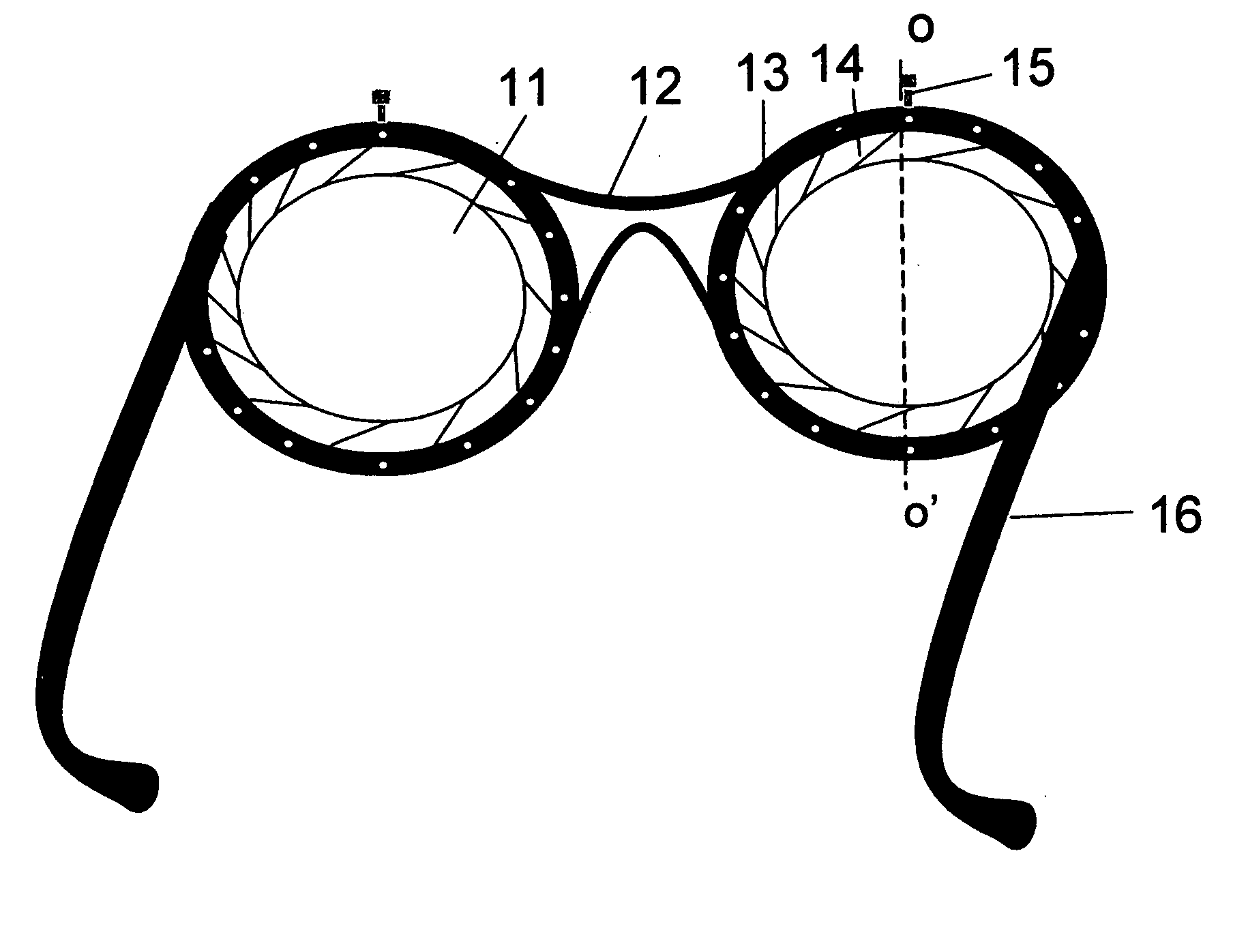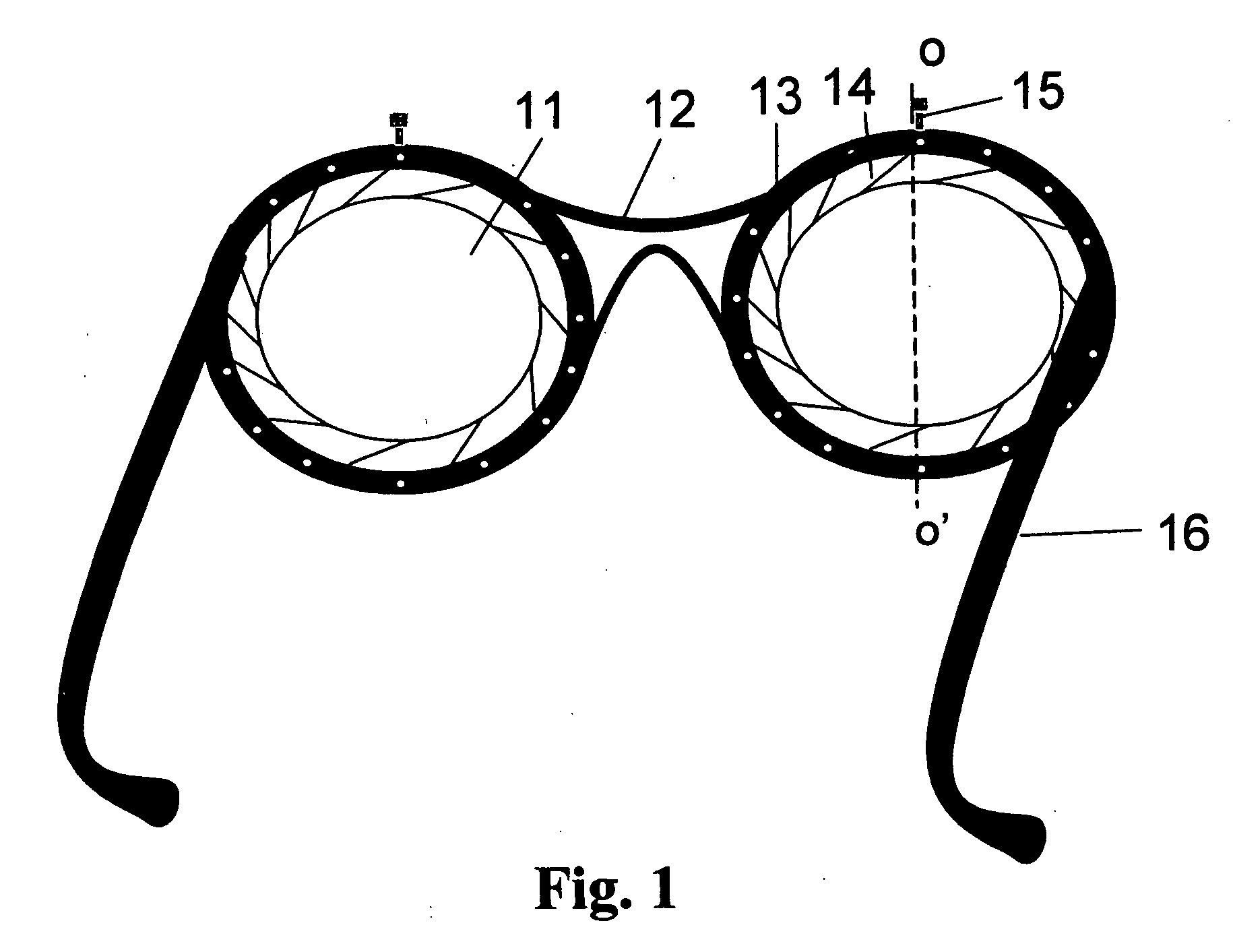Variable focus liquid lens
a liquid lens and variable focus technology, applied in the field of variable focus liquid lens, can solve the problems of large lens volume, high cost, and sensitive to vibration, and can not easily keep the periphery of the elastic membrane parallel
- Summary
- Abstract
- Description
- Claims
- Application Information
AI Technical Summary
Benefits of technology
Problems solved by technology
Method used
Image
Examples
example 1
EXAMPLE 1
CONVEX / CONCAVE LENS STRUCTURE
[0060]FIG. 1 shows a pair of spectacles using variable focus lenses according to the present invention, viewed from the wearer's side of the glasses. A unique feature of the spectacles or glasses is the lens cells. A fixed volume of clear liquid stored between the rigid substrate and the elastic membrane is sealed at the periphery edges of the substrates. The volume of the liquid can be changed significantly depending upon the thickness and size of the lens cell. The clear liquid can be water, ethanol, silicone oil, or any other clear oil. A circular periphery seal, with a movable lever actuator, is sealed with a distensible membrane then the periphery seal is adhesively attached to the lens cell. The circular periphery seal resembles a conventional iris diaphragm and has an adhesively attached rotatable impeller that can be mechanically or electro-mechanically activated with a lever. Thus, the annular or circular sealing ring with the distensi...
example 2
EXAMPLE 2
LIGHT FOCUSING POWER
[0063] The variation in optical power of an elastically deformable lens can be achieved by changing its radius. To estimate the optical focusing power, we use the lens structures shown in FIG. 3 and FIG. 4, as an example. In FIG. 3, when the radius of the lens aperture is r0=2 cm and the thickness of the lens is t=3 mm, the surface of the lens is flat and there is no focus effect. When the radius of the lens is reduced to r1=1.5 cm, as shown in FIG. 4, the redistributed liquid will produce a liquid spherical cap. The height (h) and the radius (R) of the spherical cap is 0.25 cm and 8.25 cm, respectively. If the liquid is a solvent with refractive index n=1.5, then the focal length η=R / (n−1)=16.5 cm, and the optical power is about 6.1 diopters. If the radius is reduced to r1=1.75 cm and the thickness of the lens is t=4 mm, then the optical power is about 4.8 diopters.
example 3
EXAMPLE 3
ZOOM LENS USING TWO LIQUID LENSES
[0064] A zoom lens camera using two of the tunable-focus liquid lens of the present invention is fabricated. To get an upright image in the focal plane, two liquid lenses are needed. An object is placed before a first liquid lens with a positive focal length. The distance from the object to the first liquid lens is larger than its focal length, thus a small inverted image is obtained. A second liquid lens is placed behind the first liquid lens. The second liquid lens also has a positive focal length. The distance from the formed image to second lens is much larger than its focal length, thus a second smaller inverted image is formed again. After two times imaging, a smaller upright image is received on the focal plane of the camera body. Unlike a mechanical zoom lens used in a commercial camera, the distance from the first lens to the second lens is not changed in the present invention. The focal length of the second lens is tuned to be lon...
PUM
 Login to View More
Login to View More Abstract
Description
Claims
Application Information
 Login to View More
Login to View More - R&D
- Intellectual Property
- Life Sciences
- Materials
- Tech Scout
- Unparalleled Data Quality
- Higher Quality Content
- 60% Fewer Hallucinations
Browse by: Latest US Patents, China's latest patents, Technical Efficacy Thesaurus, Application Domain, Technology Topic, Popular Technical Reports.
© 2025 PatSnap. All rights reserved.Legal|Privacy policy|Modern Slavery Act Transparency Statement|Sitemap|About US| Contact US: help@patsnap.com



